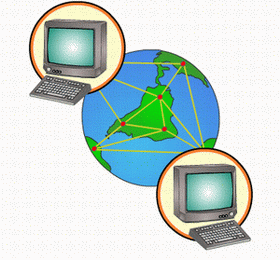Networking: Gigabyte battlefields

Researchers are developing sophisticated networking technologies that enable military commanders to share tactical information -- right from the battlefield, in real-time, experts tell United Press International.
As if out of a scene of the TV counter-terrorist drama "24," the networking software enables commanders to share -- or fuse -- information from an array of air and ground sensors. This will make the tracking of enemy ground troops, friendly troops and artillery and aircraft easier, experts said.
According to Tarunaraj Singh, associate professor of mechanical and aerospace engineering at the University of Buffalo, in the theater of war, there are usually multiple, disparate sensors with different capabilities, some of which are looking at the same targets.
"There is a need to network and fuse information from the sensors, screen out noise, get better information and reduce error in measurements," said Singh. "By combining and filtering the information, our system will give military leaders the ability to monitor the theater of war with a lens that transitions from a soda-straw view to a bird's-eye view."
The software can be used for real-time battle scenarios or for strategic planning, to predict and simulate potential movements of friends or foes. The battlefield scenarios are displayed in 3-D perspectives on a computer screen or laptop, complete with accurate representations of a region's topography.
Development of the software system is funded incrementally up to $1.59 million by an R&D grant from Rosettex Technology & Ventures Group, which works with the U.S. government's National Technology Alliance to advance and commercialize technologies that address the government's national security and defense needs, John DellaContrada, a spokesman for the university, told Networking.
Other university researchers are working on even more dynamic systems. At the University of Southern California's Information Sciences Institute, researchers are developing a geographical information system (GIS) that uses networking to overlay and assemble numerous information sources.
Another futuristic technology actually assembles tactical information into a working plan for a battlefield commander.
Called the combat commander, the technology employs a $12 million computational control system to help combat commanders make quick, accurate decisions in critical situations.
The method uses committees of virtual advisors, animated by artificial intelligence, who share information and negotiate with each other to suggest solutions.
"The system depends on effective and speedy machine-accessible communications that can track all the relevant variables in real time. But to a large degree, this information is now available. The problem is being able to comprehend the big picture quickly enough to make the right decisions. And we think that this system will be able to help." said Robert Neches, a researcher working on the project.
This system builds upon an automated system Neches created that is now in use by U.S. Marine air units to plan operations.
Just as consumers at cafes and copy shops want instant wireless access, so too do soldiers and marines. Rockville, Md.-based InHand Electronics, a provider of powerful, ultra-portable wireless device platforms, collaborated with Rajant Corp. to deploy a line of wireless network products to the field.
With the push of a single button, the so-called "BreadCrumb" wireless access point devices immediately establish a multi-unit seamlessly integrated network for setting up and maintaining wireless communications, the company said.
Suprisingly, soldiers, sailors and marines use a lot of equipment with the Macintosh operating system. But, there has not been a lot of research into building networks for those computers in the battlefield.
A budget earmark by Rep. David Obey, D-Wis., is aimed at battlefield networking solutions for the U.S. Army, which has been scrambling to link a variety of diverse systems in preparation for the so-called, Future Combat Systems unified IP effort.
Colorado Springs, Colo.-based Small Tree Communications Inc., a specialist in Macintosh networking, is to receive $3.4 million in Department of Defense funding. Small Tree's President Corky Seeber said the project would span 18 months, involving studies of secure networking protocols.
Seeber, in a statement, said his firm has already worked with Los Alamos National Labs and the Naval Research Laboratory, and can bring Mac platforms into Gigabit and 10-Gbit Ethernet networks.
Copyright 2005 by United Press International

















